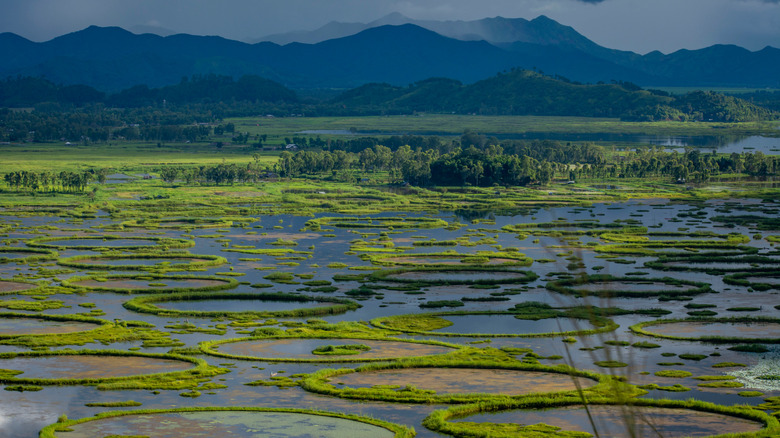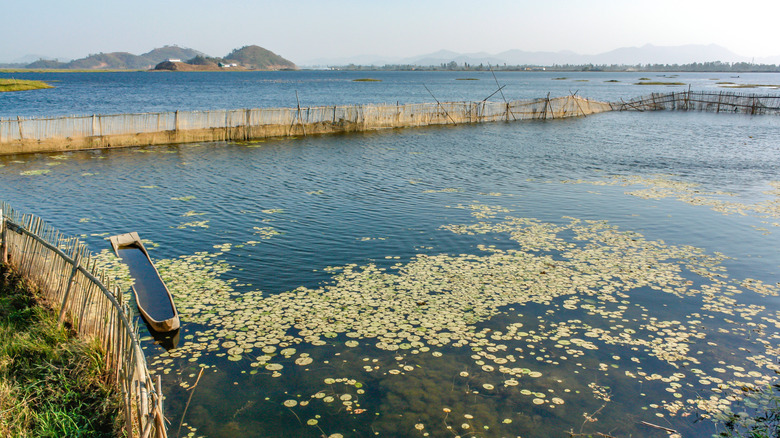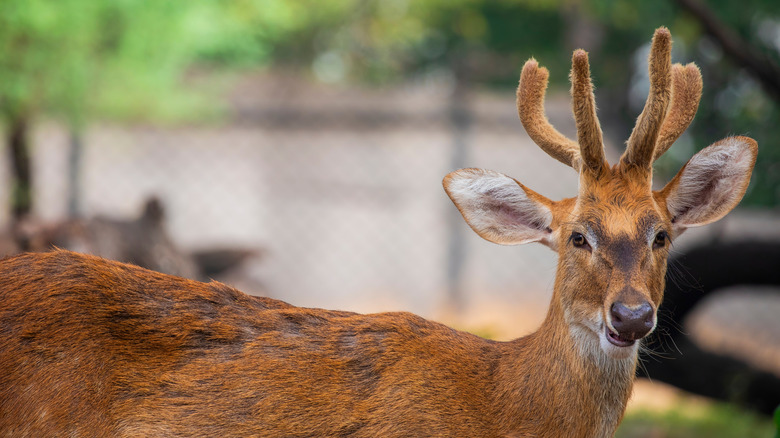The World's Only Floating National Park Is An Ethereal Natural Wonder Worth Exploring In India
Between Jaipur's artisanal crafts, luxe resorts, and palaces and Alappuzha's scenic waterways, beaches, and lagoons, India knows how to leave an impression — and most importantly, disrupt stereotypes about the country. And as striking as its man-made landmarks are, from the impressive Taj Mahal in Agra to the royal Mysore Palace in Karnataka, it's the natural wonders that truly take our breath away. Tucked in the northeast section of the country are two freshwater lakes separated by a floating grove of mystery. Keibul Lamjao National Park, situated between Loktak and Pumlen Pat Lakes, is a unique wetland reserve spanning 15.4 square miles. Not only is this the last natural habitat of the Manipur brow-antlered deer, but it's also the only floating national park in the world.
So, what exactly does a "floating national park" entail? Keibul Lamjao is a buffer between Loktak and Pumlem — an in-between water body — that's neither a marsh nor a lake. The entire surface is covered in phumdis, which consist of soil and decaying matter, some of which are large and thick enough to withstand the weight and force of a house. On top of supporting robust structures, the buoyant biomass's vegetation yields food for the wildlife.
Besides its ecological significance, Keibul Lamjao National Park and the surrounding area play a major role in the lives of the people living in the region. From recreational activities such as fishing to providing hydroelectricity and irrigation to the communities, the park's biodiversity has consistently been the center of the local culture and economy. With so much ethereal beauty to offer, you can't miss this underrated gem in India.
How to get to Keibul Lamjao National Park
India is the seventh largest country in the world, meaning you can't just hop in your car and drive from Mumbai to Keibul Lamjao National Park without preparing for a multi-day adventure. You have to carefully plan your trip so you don't end up on the road for too long. Chances are you're going to have two, maybe even three layovers to fly into the closest airport. From New York, the average journey takes anywhere between 25 and 35 hours, with one layover in Mumbai or New Delhi and another in Kolkata before landing in Bir Tikendrajit International Airport (IMF). The drive from the airport takes approximately one hour and 20 minutes. Keibul Lamjao National Park is quite far from other major cities in India, such as Jaipur, New Delhi, Hyderabad, and Mumbai, so air travel is your best bet. No matter where you're coming from, you have to be ready for the long road ahead.
Considering you're going to great lengths to see Keibul Lamjao National Park, you want to make sure to travel at the right time to witness it at its peak. Aim to visit between October and March, when the weather is cool and dry and the phumdis are more noticeable. During these months, the water levels also tend to be high, making it ideal to explore the area on a boat. As for what time to visit, it's best to arrive early in the morning, starting at 6:00 a.m., for better opportunities to spot the endangered Sangai deer.
Soak in the unparalleled beauty of Keibul Lamjao
Since the phumdis are generally sturdy enough to hold a house, you can walk on the floating islands without any difficulty and roam the national park at your own pace. Bring binoculars with you to observe birdlife — waterfowl, barn swallows, gray-headed lapwings, and other migratory birds are a common sight in the park. You might even catch a glimpse of the occasional purple heron by the tall reeds. But, of course, most visitors want to view the brow-antlered Sangai deer, endemic to Manipur and found specifically in Keibul Lamjao. This rare species was thought to have been on the brink of extinction around 75 years ago, until the local government began making efforts to increase the population. The Sangai deer usually come out in the early hours or late afternoon to feed on the grass. Watch out for wild boars, otters, and Eld's deer, too.
One of the best ways to experience Keibul Lamjao National Park is on a sunrise boat tour. You'll paddle past the phumdis and actually see how they float over the water. Don't forget your camera either — the national park has designated vantage points where you can admire the nature and snap away. If you're having a hard time spotting wildlife from the ground, make your way to the watchtower, located on a small hill, for a bird's-eye view of Keibul Lamjao — it's easily accessible by car, bike, or on foot.
Just like you should have important details in mind to prepare for visiting the Taj Mahal, you should be similarly prepared when going to Keibul Lamjao National Park. Bring essential items with you, like bug spray, snacks, and enough water to last all day. Not to mention, wear comfortable shoes so you can navigate the terrain.


